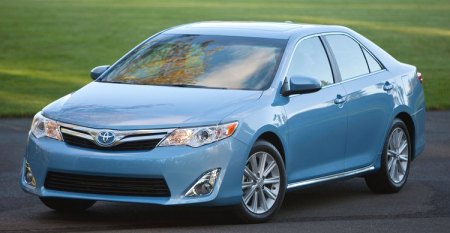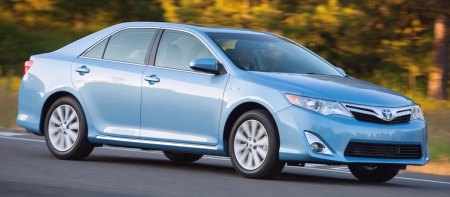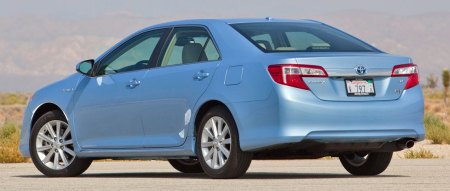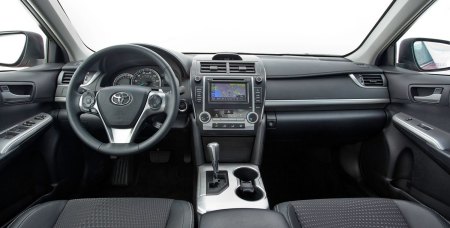|
|
|
Published
on 25
Nov 2011
|
All rights reserved.
|
|
|
 |
Here comes the 7th
generation Toyota Camry. It is a little bit more stylish, more
spacious, more refined and better built than its predecessor, yet the
philosophy running behind it is so familiar. As always, it is not
interested to steal the hearts of motoring journalists at all. We have
always been criticizing the Camry for boring to look and to drive. Even
with the latest update, I don't think it can change much of our view.
However, it is undeniable that the Camry understands the needs of
American average families much better than us, otherwise it would not
have topped the US sales chart for 13 times in the last 14 years ! Its
winning formula is simple: affordable pricing, high practicality plus
dependable quality.
Despite of its global presence, the Camry is primarily designed for the
North American market. Its size, its engines and cost structure are all
tailored to the taste of American families. On the flip side, this mean
it is difficult to achieve the same success elsewhere. In Japan, people
are put off by its large size. Its large-capacity four and six-cylinder
engines are rejected from the domestic market due to higher tax bands,
leaving only the hybrid model – which is benefited from green car tax
breaks – to soldier on. In Europe, its position is even substituted by
the smaller Avensis. Only Australia and New Zealand buy a lot of Camry,
as their social environments are closer to the US. Anyway, with North
America sales topping 400,000 units a year, Toyota does not bother to
change its philosophy yet.
 |
It might be a little exaggerating to call it "old wine in new bottle",
but the underpinnings of the new Camry is a mild evolution from the old
car. Toyota is wise to keep its size unchanged, considering the call
for lower fuel consumption. Its length, width, height and wheelbase are
all identical to the old car. Nevertheless, it still manages to
deliberate a little bit more room inside, such as 15 mm more rear
legroom and 8 mm more rear headroom, thanks to thinner front seat backs
and a flatter roof respectively. There is also more elbow room
deliberated by thinner door panels, so the car can seat 5 adults in
comfort.
The new sheet metal is more stylish than the old one, especially the
revised nose and sharper headlamps (remark: JDM version gets a slightly
different fascia and headlamps, which is not as stylish as the American
version shown here). The whole body gets more angular, losing some
softness of the old design yet it achieves a better drag coefficient at
0.28. Conservatism is still its main design theme though. It could look
bland beside a Hyundai Sonata, Kia K5 or Opel Insignia.
The monocoque chassis is made of higher percentage of high-strength
steel at locations where matter, such as A and B-pillars. This saves
weight while increases structural rigidity. Toyota claims a kerb weight
reduction of 70 kg for the petrol models. Our figures are not as good,
but still a saving of 43-52 kg is admirable when most rivals are still
gaining weight. The Hybrid is even more remarkable with a reduction of
100 kg, thanks to more compact power electronics and a smaller fuel
tank.
 |
Such weight savings are welcomed because both engines are actually
carried over from the old car. The base (also the better selling)
2.5-liter four-cylinder Dual-VVT-i engine produces 178 horsepower,
while the 3.5-liter V6 pumps out 268 horses. These figures are
unchanged from last year, but the reduced drag and kerb weight should
make the cars marginally quicker in straight line. Especially for the
case of V6, its sub-6 seconds 0-60 mph acceleration is the best among
rivals. Powertrain refinement is also good, just as expected.
To compensate the lack of direct injection and turbocharging, Toyota
reduces its fuel consumption by conventional means, i.e. a taller final
drive ratio for lower rpm crusing, lower resistance tires, the adoption
of electric power steering and the aforementioned reduced weight and
drag. Consequently, the Camry returns EPA consumption figures close to,
if not exactly matching, its more advanced rivals.
On the road, everything is familiar to the existing owners of Camry.
Although the cabin is packaged with more soft-touch materials and
better equipment, it is still more about practicality than
desirability. Drivers will welcome the slimmer A-pillars, which aid
visibility. Thanks to a tauter chassis and better insulation, wind and
road noise is even more subdued than before. Ride quality is improved
again. The car still biases strongly towards the comfort side, as its
old-fashioned all-strut suspension is not as all-round as modern
multi-link setups. Keen drivers will continue to dislike this car for
its floaty ride on high-speed undulations, its relatively loose body
control or its numb steering, especially on the 2.5-liter model where a
cheaper EPS is used (V6 gets a more expensive EPS, which has a more
progressive response and better weighting, if not more road feel).
Admittedly, the new Camry is sharper to handle than ever, but that is
only in relative terms. As rivals are also progressing, its gap remains.
 |
In America, you can choose the sportier SE model, which comes with 15
percent stiffer springs, 50 percent firmer dampers and revised
steering. Still, it can't overcome the limitation of its suspension
geometry. If you push it into corner, you will get lots of body roll
and understeer that you won't find in an American Volkswagen Passat or
Ford Fusion.
For this reason, I think the powerful V6 is a waste of materials and
fuel. The most senisble model should be the Hybrid. It is also the most
improved among the three. By using a new 2.5-liter Atkinson-cycle
engine and higher efficiency hybrid components, it achieves an EPA
rating of 41 mpg city and 38 mpg highway, some 25 percent better than
the old car! It goes without saying that it tops the class for fuel
economy. The hybrid is also a bit more powerful, with a combined output
of 200 hp instead of the previous 187 hp. Besides, the electric brake
and throttle have been reworked to deliver much more linear response,
matching its best rivals. Finally, the Camry Hybrid is very reasonably
priced. Toyota uses its matured hybrid technology and superior economy
of scale to trump rivals on price lists.
All these improvements sound subtle when compare with its fast
progressing rivals, but the Camry still shines on its traditional
strengths – dependable quality, high practicality and affordable
prices. Now also enters green credential. A desirable car it may never
be, the Camry should satisfy the majority of family men and women.
|
Verdict:    |
Published
on 28
Sep 2014
|
All rights reserved.
|
|
Camry facelift 2014
|
|
With the
introduction of new Honda Accord, Mazda 6, Chrysler 200 and Hyundai
Sonata, competition in the American mid-size family sedan segment gets
intensified. Sales leader Toyota Camry needs a refresh to fend off the
competition. Toyota said the facelift involve 2000 new components, but
it seems to me most changes are focused on the outside. When the Mk7
arrived in late 2011, it was criticized for looking like a soap bar. To
make the soap bar more stylish is not easy. Toyota's designers at the
California studio gave it a prominent cheese slicer grille and reshaped
headlamps at the nose. On the sportier SE model (red car below), it
even gets an aggressive mesh grille which is quite an eyesore to me. At
the side, in order to make the C-pillar to appear slimmer without
actually modifying the monocoque chassis, it adds a piece of black
plastic to the pillar, pretending to be an additional quarter window.
These makeups actually destroy the harmonious feel of the original
design.
The rest of the car gets relatively little attention. The cabin gets
only minor upgrades of equipment, trims and sound insulation. The three
choices of powertrain, i.e. 2.5-liter four, 3.5-liter V6 and 2.5-liter
hybrid, are carried over intact. The chassis has added some spot welds
to increase rigidity. Other modifications include 10 mm wider tracks,
slightly retuned suspensions and power steering.
On the road, the Camry is a marginally slower than the outgoing car
thanks to the extra weight of a few dozen kilograms, but it is still
quick enough, especially the V6. Noise level is noticeably lowered, but
the promise about improved ride quality, handling and steering response
are too slim to be detectable. This means it is still one of the most
boring family cars to drive.
|
Verdict:    |
|
|
|
|
|
|
|
|
|
|
Camry 2.4
|
2011
|
| Front-engined,
FWD |
| Steel monocoque |
Mainly steel
|
| 4805 / 1820 / 1470 mm |
| 2775 mm |
Inline-4
|
| 2494 cc |
DOHC 16 valves, DVVT
|
| - |
| - |
178 hp
|
170 lbft
|
6-speed automatic
|
F: strut
R: strut
|
| - |
215/60R16
|
1447 kg
|
| - |
8.2* / 7.8**
|
22.9*
|
|
Camry 3.5 V6
|
2011
|
| Front-engined,
FWD |
| Steel monocoque |
Mainly steel
|
| 4805 / 1820 / 1470 mm |
| 2775 mm |
V6, 60-degree
|
| 3456 cc |
DOHC 24 valves, DVVT
|
| - |
| - |
268 hp
|
248 lbft
|
6-speed automatic
|
F: strut
R: strut
|
| - |
225/45VR18
|
1528 kg
|
| - |
5.8* / 5.8**
|
14.1* / 13.9**
|
|
Camry Hybrid
|
2011
|
| Front-engined,
FWD |
| Steel monocoque |
Mainly steel
|
| 4805 / 1820 / 1470 mm |
| 2775 mm |
Inline-4, Atkinson cycle,
electric motor
|
| 2494 cc |
DOHC 16 valves, VVT
|
| - |
| - |
156 hp (engine)
141 hp (motor)
200 hp (combined) |
156 lbft (engine)
199 lbft (motor) |
| CVT |
F: strut
R: strut
|
| - |
215/55R17
|
1561 kg
|
| - |
7.3* / 7.2**
|
18.9*
|
|
|
|
|
|
Performance
tested by: *C&D, **MT
|
|
|
|
|
|
|
|
|
Copyright©
1997-2014
by Mark Wan @ AutoZine
|
|